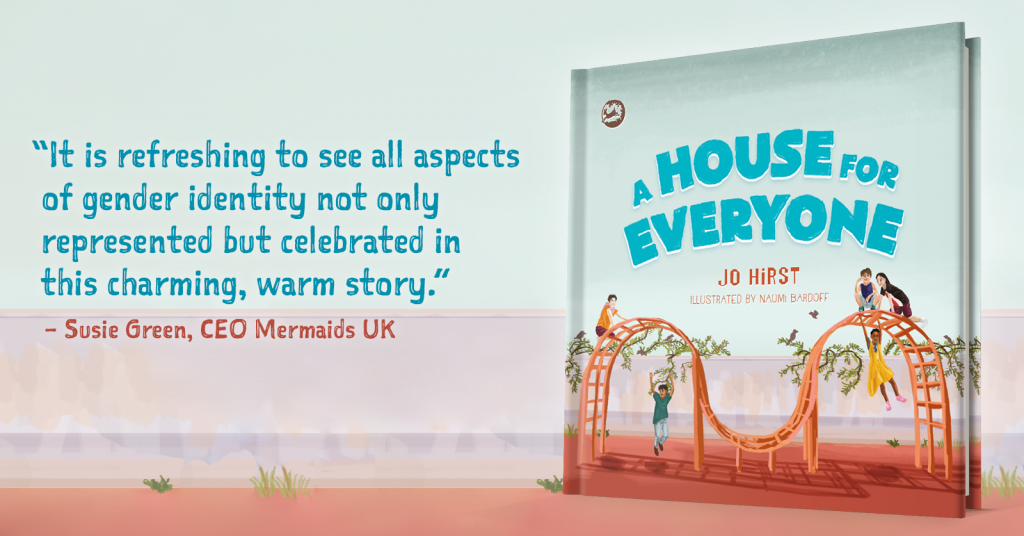This is the second book from Jo Hirst, author and mother of a trans child. She is a board member of the group Parents of Gender Diverse Children and a well-known trans advocate in Australia, where she lives. Here, she reflects on the importance of having books like ‘A House for Everyone,’ that break down gender stereotypes and encourage children to be who they want to be.
All children deserve to see themselves reflected in picture books. It helps all of us to feel connected to our community and our wider world when we see ourselves included in media, films and books.
When I wrote my first book, The Gender Fairy, it was to help young transgender children, like my own child, feel normal and not so alone. It was also to help their friends gain a bit more understanding to help support their peers at school. Nothing makes me happier than seeing children who are thriving because they are completely supported as themselves.
Now that our society is gaining a greater understanding of gender diverse children, we are seeing more families and schools supporting kids to be themselves than ever before. The Royal Children’s Hospital, in Melbourne, Australia, puts the number of transgender children in our schools at 1.2% conservatively. That’s at least one in every hundred children, in every school. The Telethon Kids Institute in Australia released research in 2017 that told us that 48.6% of the young people they surveyed, identified as non-binary. That is, not identifying as exclusively male or female. We have experience and research that tells us that when families, communities and schools support transgender children, they have the same mental health and academic outcomes as their peers. Alternatively, we also have extensive research that shows us the dangers of not supporting transgender youth.
I’m privileged enough to see the positive benefits and positive long-term outcomes of affirming and supporting transgender young people through the families I talk to in Australia and around the world.
My new book, ‘A House for Everyone,’ is about showing that it is not only gender diverse and gender non-conforming young people who benefit from inclusion and support. All children benefit not only from understanding diversity but from the breaking down of gender stereotypes.
‘A House for Everyone,’ is written to help all children know that it is ok to be themselves. It also provides adults with a resource to help children learn about gender identity and gender expression and break down some of the barriers around gender. The story is based on a game that my own young son played with his friends at school. Five young children build a house together at lunchtime, combining their very different skills. It’s a game of cooperation.
Ivy is a fast runner. She has very short hair and always wears shorts and a t shirt. She is the leader of the group.
Sam is an artistic boy with long hair, who loves flowers and sport.
Jackson is a boy who loves dresses and tiny teddies.
Alex does not feel like just a boy or just a girl.
Tom is happy now that everyone knows he is a boy and he has a new name. He was really sad when everyone thought he was a girl.
The five children all have very different gender identities and gender expressions. None of these are stereotypical. But they all enjoy each other’s company. They all respect one another’s choices. They are all friends.
“Boys are strong and girls are pretty.” These are just some of the gender stereotypical messages society gives our children through media, advertising, movies, books and even in the local toy and clothing shops. The pushback against the relentless gendered marketing of toys and clothes for children is gaining momentum across the western world. There’s an important reason for that.
Throughout the world, we are seeing research that shows us the long-term risks of imposing rigid gender stereotypes on very young children. We know that breaking down gender stereotypes in very young children can reduce domestic violence later in life, increase career prospects, promote healthier relationships and self-esteem. Plan International Australia, while acknowledging that global gender discrimination for girls is “dire,” published research last year that gave “rare insight” into how young Australian girls feel the impact of gender discrimination in their lives today. 98% of girls felt they didn’t receive equal treatment to boys.
Associate Professor, Kristin Mmari, lead researcher for the qualitative research at the Global Early Adolescent Study says, “Adolescent health risks are shaped by behaviours rooted in gender roles that can be well established in kids by the time they are 10 or 11 years old,” Mmari said. “Yet we see billions of dollars around the world invested in adolescent health programs that don’t kick in until they are 15 and by then it’s probably too late to make a big difference.”
I’m grateful that our society is becoming a safer and more supportive place not only for my child, but for all children who don’t meet our cultural expectations of gender. My hope is that A House for Everyone, gives all children more room to breathe and an opportunity to thrive knowing that:
It’s ok if your gender identity or gender expression does not fit neatly into a box.
There are no clothes or toys that belong to just one gender.
Anyone can play with the toys they enjoy.
All children can wear the clothes that they find comfortable.
For more information or to buy a copy of ‘A House for Everyone,’ click here.
Follow Jo Hirst on Twitter @thegenderfairy1
Follow JKP on Twitter @JKPGender or find us on Facebook @JKPGender.
For more exclusive content from our authors, why not join our mailing list?
